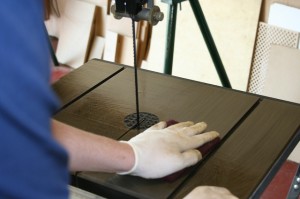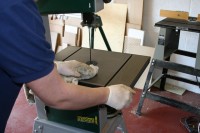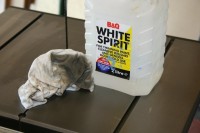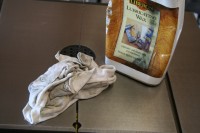A quick guide showing how to get your cast iron machine tables rust-free & looking like new…

In my workshop, like many people I have a problem with rust and without regular care my lovely, shiny cast-iron tables turn a not so lovely rusty brown. My bandsaw table is quite an extreme case mainly as it’s been stuck in a corner and hasn’t had any use for a few months. But fear not, it isn’t as bad as it looks, with a bit of work it can once again look like new. There’s no magic involved – just plain old fashioned elbow-grease…
The first step is to brush the table down and clear away any dust or chips. To get the rust off I use webrax. I normally either use the grey or brown sheets on my tools and machines. As the bandsaw table was in pretty bad shape I used ‘brown’ webrax which is courser then the grey sheets. I like to use CMT router cutter cleaner as it helps removes the muck and I find it’s a good lubricant for the webrax. I’ve also used WD40 in the past as well.

With the sheet of webrax folded in half I work on removing the rust and cleaning the table, applying even pressure. If you don’t fancy all the elbow-grease you could attach the webrax to your ROS or palm sander. It’s a messy job so to save getting black hands and finger nails it’s worth wearing a pair of disposable gloves.

Once I’m satisfied all the rust and marks have gone, I wipe the table clean with an old towel to remove the bulk of the gunk left behind.

I then like to clean the table with white spirit to remove any left over lubricant and gunk.

When the table is rust-free and dry the next step is to protect it. I use Liberon lubricating wax, it helps prevents corrosion and rust, keeps the table smooth so timber slides along it easily and it’s silicon free. I apply a generous amount then leave it to dry for about 10mins. Once dry I give it a light buff with a clean cotton cloth. I normally apply two coats which I find gives good protection. I then apply regular coats every few weeks (if I remember).To avoid building up too many layers of wax, I cut it back with white spirit when it needs it. And that’s it!… Each woodworker has slightly different methods of preventing and removing rust and that you’ll probably pick up your own maintenance routine over time, but I hope you find the information I’ve provided useful.

In my workshop, like many people I have a problem with rust and without regular care my lovely, shiny cast-iron tables turn a not so lovely rusty brown. My bandsaw table is quite an extreme case mainly as it’s been stuck in a corner and hasn’t had any use for a few months. But fear not, it isn’t as bad as it looks, with a bit of work it can once again look like new. There’s no magic involved – just plain old fashioned elbow-grease…
The first step is to brush the table down and clear away any dust or chips. To get the rust off I use webrax. I normally either use the grey or brown sheets on my tools and machines. As the bandsaw table was in pretty bad shape I used ‘brown’ webrax which is courser then the grey sheets. I like to use CMT router cutter cleaner as it helps removes the muck and I find it’s a good lubricant for the webrax. I’ve also used WD40 in the past as well.

With the sheet of webrax folded in half I work on removing the rust and cleaning the table, applying even pressure. If you don’t fancy all the elbow-grease you could attach the webrax to your ROS or palm sander. It’s a messy job so to save getting black hands and finger nails it’s worth wearing a pair of disposable gloves.

Once I’m satisfied all the rust and marks have gone, I wipe the table clean with an old towel to remove the bulk of the gunk left behind.

I then like to clean the table with white spirit to remove any left over lubricant and gunk.

When the table is rust-free and dry the next step is to protect it. I use Liberon lubricating wax, it helps prevents corrosion and rust, keeps the table smooth so timber slides along it easily and it’s silicon free. I apply a generous amount then leave it to dry for about 10mins. Once dry I give it a light buff with a clean cotton cloth. I normally apply two coats which I find gives good protection. I then apply regular coats every few weeks (if I remember).To avoid building up too many layers of wax, I cut it back with white spirit when it needs it. And that’s it!… Each woodworker has slightly different methods of preventing and removing rust and that you’ll probably pick up your own maintenance routine over time, but I hope you find the information I’ve provided useful.


































